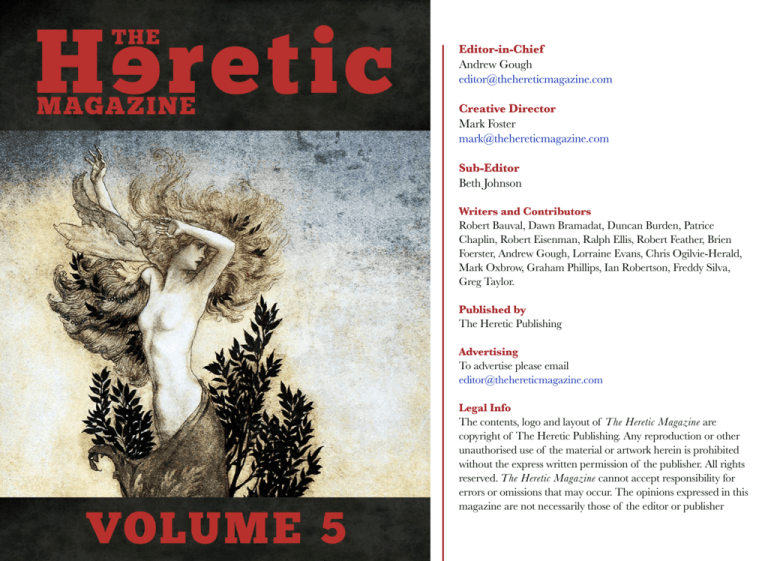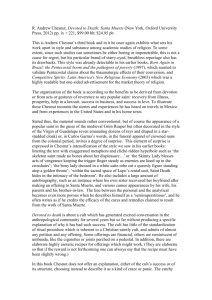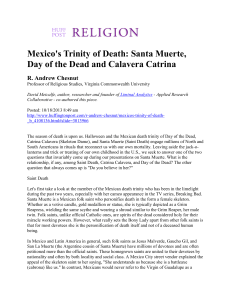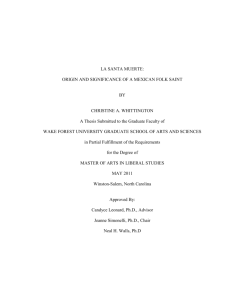
Editor-in-Chief
Andrew Gough
editor@thehereticmagazine.com
Creative Director
Mark Foster
mark@thehereticmagazine.com
Sub-Editor
Beth Johnson
Writers and Contributors
Robert Bauval, Dawn Bramadat, Duncan Burden, Patrice
Chaplin, Robert Eisenman, Ralph Ellis, Robert Feather, Brien
Foerster, Andrew Gough, Lorraine Evans, Chris Ogilvie-Herald,
Mark Oxbrow, Graham Phillips, Ian Robertson, Freddy Silva,
Greg Taylor.
Published by
The Heretic Publishing
Advertising
To advertise please email
editor@thehereticmagazine.com
Legal Info
The contents, logo and layout of The Heretic Magazine are
copyright of The Heretic Publishing. Any reproduction or other
unauthorised use of the material or artwork herein is prohibited
without the express written permission of the publisher. All rights
reserved. The Heretic Magazine cannot accept responsibility for
errors or omissions that may occur. The opinions expressed in this
magazine are not necessarily those of the editor or publisher
“From the second Elohim till the third, five words appear. From
here on: light – created, concealed, contained in the covenant,
entering the rose, emitting seed into Her. This is the tree bearing
fruit with its seed in it. That seed endures in the actual sign of
covenant. Just as the image of the covenant is sown in forty-two
couplings of that seed, so the engraved, explicit name is sown into
forty-two letters of the act of Creation.”
– Haqdamat Sefer ha-Zohar (Introduction to the Zohar)
The earliest written records noting a ‘Santa Muerte’ date to the eighteenth
century. In 1797 an Inquisition record, named ‘Concerning the Superstitions
of Various Indians from the Town of San Luis de la Paz’ tells us that a
group of ‘thirty Indians’ met in the ‘silence of night’ and drank peyote in
their chapel. They lit candles ‘backwards’, made little dolls dance, struck at
crucifixes with wax candles and tied up a figure of Santa Muerte with wet
cord, threatening to whip it if it failed to miraculously meet their demands.
Then, for over 200 years, Saint Death all but vanished . . .
Welcome to Tepito, one of Mexico City's most dangerous
neighbourhoods. You step up on the sidewalk, walking
quickly. The streets are crowded with families setting up
market stalls under a patchwork of yellow and green
tarpaulins. You can buy almost anything in the street
markets of Tepito: burritos, huaraches, quesadillas,
tequila, pirated movies and music, counterfeit clothes and
sneakers, fake toys, narcotics, illegal firearms. Concrete
walls are painted with murals and littered with graffiti. A
torn lucha libre poster peels from a telephone pole. An
elderly lady smiles as you buy a red candle from her stall.
You turn the corner and there, grinning down at
you from her altar, is Saint Death. Santa Muerte’s skull
face stares out from her veil. Her bones are shrouded in
the folds of her white wedding dress. She holds a scythe,
like the grim reaper, in one skeletal hand. In the other
hand she holds the orb of the world. Santa Muerte’s
followers dress and tend her with care. Her bony neck is
strung with bead necklaces and she wears a thin gold
crown. Her altar is lit by hundreds of candles and
covered in offerings of flowers, cigarettes, money, apples,
chocolate and alcohol.
Santa Muerte has been
condemned as ‘infernal’ by the
Catholic Church, labelled a
‘narco-saint’ and flagged in
connection with drug violence,
ritual murder and human sacrifice
by FBI and US Marshal officers
Millions pray to Santa Muerte in her native
Mexico. She has devotees in all walks of life, from police
officers, lawyers and prison guards, dressmakers,
hairdressers and grandmothers, to prostitutes, drug
dealers, gang leaders and murderers.
Santa Muerte has been condemned as ‘infernal’ by
the Catholic Church, labelled a ‘narco-saint’ and flagged
in connection with drug violence, ritual murder and
human sacrifice by FBI and US Marshal officers.
In a few short years her cult has blossomed and
spread across the border into the United States. Santa
Muerte chapels and altars can be found from Los Angeles
and San Francisco Bay to Washington DC and New York
City. Her cult has laid down roots in New Mexico, Texas
and Arizona and is growing across America, as the Skinny
Lady steps out of the shadows into the mainstream.
Close-up view of a Santa Muerte south of Nuevo Laredo, Mexico
Some have argued that Santa Muerte’s origins can
be traced back to ancient Aztec death-goddess,
Mictecacihuatl. Mictecacihuatl ruled the underworld
alongside her husband, the god, Mictlantecuhtli. They
were the Lord and Lady of the Mictlan, the Aztec
realm of the dead. Mictecacihuatl watched over the
bones of the dead in the afterlife and appeared as a
living skeleton. It was said that her mouth gaped wide
open so she could devour the stars in the sky.
Could devotion to an Aztec goddess really have
survived in secret for almost 500 years? The Spanish, led
by Hernando Cortes, conquered the Aztecs under
Montezuma in 1521. The great Aztec capital,
Tenochitlán, fell. The Spaniards destroyed it and founded
Mexico City in its place. Some say that belief in
Mictecacihuatl, the ‘Keeper of the Bones’, survived the
Spanish conquest and resurfaced in the celebration of El
Día de los Muertos – the Day of the Dead.
The earliest written records noting a ‘Santa Muerte’
date to the eighteenth century. In 1797 an Inquisition
record, named ‘Concerning the Superstitions of Various
Indians from the Town of San Luis de la Paz’ tells us that
a group of ‘thirty Indians’ met in the ‘silence of night’
and drank peyote in their chapel. They lit candles
‘backwards’, made little dolls dance, struck at crucifixes
with wax candles and tied up a figure of Santa Muerte
Raising of Santa Muerte images during a service for
the deity on Alfareria Street, Tepito, Mexico City
with wet cord, threatening to whip it if it failed to
miraculously meet their demands.
Then, for over 200 years, Saint Death all but vanished.
Santa Muerte emerged in 2002 when Señora
Enriqueta Romero Romero (known to devotees as Doña
The Cruz family cares for a carved
wooden statue of Santa Muerte.
Her skull face gazes out as devotees
bring her offerings, but for many
years this statue stood in a local
church. The church said the statue
was Saint Bernard of Clairvaux
Queta) carried her statue of the Skinny Girl out of her
one-bedroom home to Alfarería Street in Tepito, Mexico
City. Doña Queta set up a public altar to Santa Muerte,
which now attracts devotees from across Mexico and all
the way from the United States.
Doña Queta had been a believer in Santa Muerte for
many years, but she kept her devotion secret as the
Catholic Church was opposed to Saint Death. Decades
after she first prayed to Saint Death, Doña Queta's son
made his mother a gift of a huge Sante Muerte statue.
She decided it was simply too large to set up inside her
home and finally felt able to make her devotion public.
In the town of Tepatepec, Hidalgo, the Cruz family
cares for a carved wooden statue of Santa Muerte. Her
skull face gazes out as devotees bring her offerings, but for
many years this statue stood in a local church. The church
said the statue was Saint Bernard of Clairvaux. (Saint
Bernard built the Cistercian order and wrote the Rule of
the Knights Templar.)
Catholic churches around the world contain the relics
of saints and martyrs. I once spent a surreal day in Paris. I
visited the city’s cathedrals and chapels and saw tiny
fragments of saints’ teeth and shards of bone wrapped in
gold thread, cushioned on red velvet in gold caskets. That
morning I visited the Parisian catacombs, where thousands
and thousands of skulls and bones are piled high and are
crafted into decorative chambers and tunnels.
But the precious relics of the saints are believed to be
the mortal remains of men and women that lived and
died. Santa Muerte was never ‘alive’ and she never died.
She is a living skeleton. Death incarnate.
This devotion to Saint Death is condemned by the
Catholic Church. The Bible, in Romans 6:23, states ‘the
wages of sin is death’. The Church teaches that death is
God’s punishment for sin. In the Garden of Eden, when
Adam and Eve disobeyed God by eating the fruit of the
tree of knowledge of good and evil, their sin condemned
all human lives to end in death. Jesus Christ faced many
enemies during his life, but his last enemy was death
itself. Jesus conquered death when he was resurrected
following the crucifixion. A Mexican priest, Father
Sergio Roman, put it simply: ‘to worship death is to
worship the enemy of Christ.’
In 2009 the Mexican President, Felipe Calderon,
ordered the destruction of Santa Muerte altars. More
than forty holy sites along the United States/Mexico
border were bulldozed, the altars razed to the ground.
The Mexican Government had effectively declared war
on the Skinny Girl.
In the last few years the Catholic Church and the
Mexican Government have fought against the cult of
Santa Muerte, but devotion to the Bony Lady has
continued to grow. After Pope Benedict XVI resigned, the
Argentine Cardinal, Jorge Mario Bergoglio, became Pope
Francis, the first Latin American Pope. He leads a
Catholic Church that is at war. It is waging a global
conflict to win souls as the twenty-first century sees the
world grow increasingly secular and the church’s
influence decline. Latin America is a major battlefield and
the Catholic Church is losing.
Cardinal Gianfranco Ravasi, the President of the
Pontifical Council for Culture, is seen as a modern thinker
in the Catholic Church. He famously tweeted the chorus
of Lou Reed's song Perfect Day when the legendary singer
died. In 2013 Cardinal Ravasi condemned the cult of
Santa Muerte as ‘blasphemous’, encouraging devotees in
Mexico to abandon the folk saint. He said, ‘religion
celebrates life, but here you have death... It’s not religion
Young man with
Santa Muerte
image on Alfareria
Street, Tepito,
Mexico City, after
service to the deity
just because it’s dressed up like religion; it’s a blasphemy
against religion.’
Cardinal Ravasi reinforced the image of the Bony
Lady as a narco-saint:
The mafia, drug trafficking and organised crime
don’t have a religious aspect and have nothing to
do with religion, even if they use the image of
Santa Muerte.
I spoke to Dr R. Andrew Chesnut, a leading expert on
Santa Muerte, asking if the Vatican’s denunciation would
make believers turn away from the Skeleton Saint:
No, the Cardinal’s condemnation won’t have an
impact on devotees. Most Santa Muertistas are
not institutionally practising Catholics, so many
aren’t aware of the denunciation and others
really don’t care.
Dr Chesnut is Professor of Religious Studies at Virginia
Commonwealth University and author of Devoted to Death,
the world’s first academic work on Santa Muerte. He was
first drawn to Saint Death in 2009, when the Mexican
Government had Santa Muerte shrines destroyed as part
of their war against the drug cartels.
In recent years Saint Death has appeared in National
Geographic, the Washington Post, the Los Angeles Times, the
Huffington Post and Time Magazine. She has appeared in
shocking headlines linked to prostitution, kidnapping,
people-smuggling, the drug trade and ritual murder.
Read the full article in Volume 5 of
The Heretic Magazine
“There was a profound experience that
happened when he left his body. It was
visible. Let’s just say, you wouldn’t need
to light the room if you were trying to
film it. He just . . . lit the room.”
‘SUNRISE DOESN’T LAST ALL MORNING, a
cloudburst doesn’t last all day,’ sang George Harrison on the
title track to his first post-Beatles solo album, All Things Must
Pass. Although the song is naturally seen as an ode to the
impermanence of human life, the lyrics also note that neverending change means that those left grieving can look to the
future with hope: ‘Darkness only stays at night-time, in the
morning it will fade away.’ But Harrison also intimated,
through lyrics written in the first person, that those who die
might move onwards too: ‘None of life’s strings can last, so I
must be on my way, and face another day.’
Three decades after writing this song the former
Beatles guitarist went ‘on his way’ in the literal sense,
All things must pass. George Harrison in Vrindavan, India, 1996
Neuropsychiatrist, Peter
Fenwick, was amazed to find in
a survey of palliative carers that
one in every three reported
accounts of ‘a radiant light that
envelops the dying person, and
may spread throughout the
room and involve the carer.’
dying on 29 November 2001, aged just 58, after a battle
with lung cancer. Is it possible that Harrison (a devotee of
Indian mysticism) truly did move on, in some sense, to
‘face another day’? Intriguingly, the extraordinary life of
George Harrison seems to have been matched with an
extraordinary death, going on the events his wife Olivia
witnessed as the former Beatle shed this mortal coil:
There was a profound experience that happened
when he left his body. It was visible. Let’s just say,
you wouldn’t need to light the room if you were
trying to film it. He just . . . lit the room (Living in
the Material World, documentary by Martin
Scorsese, 2011).
The lazy response to the above testimony would be to mark
down Olivia Harrison’s observations as hyperbole – the
poetic wish-fulfilment of a grieving wife – except for the
fact that she is far from alone in witnessing strange
phenomena such as this at the deathbed of a loved one. As
I pointed out in my recent book, Stop Worrying! There
Probably is an Afterlife, there have in fact been numerous cases
in which those caring for the dying have described seeing a
bright light surrounding the dying person, exuding what
they relate as ‘a raw feeling of love’ (Dr Peter Fenwick:
‘Dying: A Spiritual Experience as Shown by Near Death
Experiences and Deathbed Visions’, 2004). And when I say
‘numerous’, I am not exaggerating: neuropsychiatrist, Peter
Fenwick, was amazed to find in a survey of palliative carers
that one in every three reported accounts of ‘a radiant light
that envelops the dying person, and may spread throughout
the room and involve the carer’, a description which sounds
remarkably similar to the ‘profound experience’ recounted
by Olivia Harrison. In a similar Dutch study the numbers
were even more staggering: more than half of all carers
reported observations of this ‘dying light’!
Read the full article in Volume 5 of
The Heretic Magazine
In my previous article, in Issue 4 of the Heretic Magazine and adapted from
the books, King Jesus and Mary Magdalene, we saw that both the Old and
New Testaments are actually infused with a great deal of astrology, if we did
but know how to discover and identify it. Having done so, it would appear
that a large segment of ancient Judaism and original Christianity actually
dealt with the veneration of precessional astrology/astronomy. Why? It is
my assertion that this veneration arose because this was the only accurate
method of maintaining a royal and a cultural history over many millennia
WITH PRECESSIONAL ASTROLOGY YOU ONLY
need to mention the symbol of the zodiac that an event or
monarch was associated with, and the era for that event or
monarch can be narrowed down considerably – sometimes
to just a few years.
The fact that the Israelites were Shepherds (Aries)
and they were battling with Apis-bull worshippers
(Taurus) during the infamous ‘golden calf ’ affair at the
foot of Mount Sinai, immediately tells us that this event
occurred just after the constellation of Taurus had ceded
its dominant position to Aries, at the vernal equinox (the
spring equinox). In other words, this slaughter of the
Apis-bull worshippers by Moses happened just after the
Great Month of Taurus turned into the Great Month of
Aries in about 1750 BC. And if we equate the Israelite
Exodus with the Hyksos shepherds’ Exodus out of Egypt
to Jerusalem (as narrated by Manetho), then this would be
correct, for the accepted date is around 1570 BC (this
religious dispute had simmered for more than a century).
Likewise, when Pharaoh Alexander III and Pharaoh
Ptolemy III were pictured wearing the horns of the ram,
this also identified them with the Great Month of Aries,
which ended in about AD 10. And, in a similar fashion,
Jesus’ peculiar transmutation from a Lamb of God (Aries)
to a Fisher of Men (Pisces) places his birth in the early
first century, which it evidently was.
Thus, it would appear that the ancient Egypto-Judaic
priesthood were guardians of the Day Book, the diary
and biography of the royal dynasties of the EgyptoJudaeans and, to track those dynasties and the many
momentous events in their lives, they used precessional
astronomy to shape their chronological framework. They
no doubt also used precessional astronomy to make
predictions for the future, and thus secured their exalted
position within Egypto-Judaean society as the guardians
of all wisdom, be that for the past, present or future.
But our knowledge of precessional astronomy was
nearly exterminated in AD 70, when Jerusalem was
destroyed by the Romans (The Jewish Wars, Josephus
Flavius). As I relate in the books, King Jesus and Jesus, King
of Edessa, Jesus was not a pauper prince of peace, but a
warrior king of Edessa in northern Syria – of the very
same family who fomented and prosecuted the Jewish
revolt in AD 70, according to the historians Josephus
Flavius and Moses of Chorene. The aim of this royal
family had been to take over the Roman east, with a view
to taking over the entire Roman Empire (the throne of
Rome being vacant at this time). But the plan went
horribly wrong when the Romans used the might of their
near-invincible army to ravage Judaea and destroy
Jerusalem. In this era the great traditions of precessional
astrology were held almost exclusively by the Nazarene
Fourth Sect of Judaism – the Church of Jesus and James
– and so the destruction of the Nazarenes of Edessa was
very nearly a terminal blow to the veneration of the
precessional zodiac (as opposed to the veneration of the
emasculated annual zodiac that we see in magazines
today). If a knowledge of precession was to survive, then
these ancient traditions would have to be relocated
elsewhere and, if necessary, go underground. So where
did they go?
Arthur’s Round Table
Surprisingly, it is my contention that many of these
ancient traditions were transferred to England, where
they became the foundation for mythologies that
underpin the legends of King Arthur. It matters not at
this stage whether King Arthur was a real person or not,
as we are only looking here at the traditions and
symbolism that surround this famous monarch. The
identification of King Arthur in the historical record is
another matter entirely, although the book, King Jesus, did
come up with some rather startling evidence as to who
King Arthur really was.
So, in what manner is the precessional zodiac
related to the legends of King Arthur? Well, it would
seem that the historical and mythical thread for the
zodiac is interwoven into the legends of the Arthurian
Round Table, as narrated in the Vulgate Cycle, that
enormous, but turgid and impenetrable, corpus of
Arthurian legend that is well known for its soporific
effect. (The Vulgate Cycle, also called the Lancelot–Grail, is
of uncertain authorship, but claimed to be by Walter
Map. One of the books of the Vulgate Cycle is Quest for the
Holy Grail (Queste del Saint Graal).)
Within this great Arthurian library there are many
accounts of the Round Table and one of them, Quest for
The Last Supper mosaic by Giacomo Raffaelli, a copy of
Leonardo da Vinci’s famous Last Supper mural. In reality,
the Last Supper table was a round, Arthurian-style table
Read the full article in Volume 5 of
The Heretic Magazine
Pessinus: The Origin
of Cybele’s Abduction
and the Attis Myth
Andrew Gough
In our current instalment of Hidden
Gems, Heretic Editor, Andrew Gough,
travels to an obscure, but important,
site in his new homeland of Turkey.
What he found amazed him.
http://www.thehereticmagazine.com/






